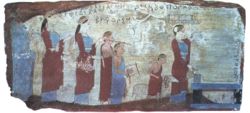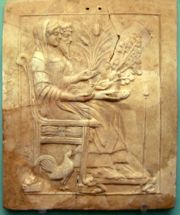
Pinax
Encyclopedia

Ancient Greece
Ancient Greece is a civilization belonging to a period of Greek history that lasted from the Archaic period of the 8th to 6th centuries BC to the end of antiquity. Immediately following this period was the beginning of the Early Middle Ages and the Byzantine era. Included in Ancient Greece is the...
and Magna Graecia
Magna Graecia
Magna Græcia is the name of the coastal areas of Southern Italy on the Tarentine Gulf that were extensively colonized by Greek settlers; particularly the Achaean colonies of Tarentum, Crotone, and Sybaris, but also, more loosely, the cities of Cumae and Neapolis to the north...
, a pinax (πίναξ) (plural pinakes - πίνακες) or a "board", denotes a votive tablet of painted wood
Wood
Wood is a hard, fibrous tissue found in many trees. It has been used for hundreds of thousands of years for both fuel and as a construction material. It is an organic material, a natural composite of cellulose fibers embedded in a matrix of lignin which resists compression...
, terracotta, marble
Marble
Marble is a metamorphic rock composed of recrystallized carbonate minerals, most commonly calcite or dolomite.Geologists use the term "marble" to refer to metamorphosed limestone; however stonemasons use the term more broadly to encompass unmetamorphosed limestone.Marble is commonly used for...
or bronze
Bronze
Bronze is a metal alloy consisting primarily of copper, usually with tin as the main additive. It is hard and brittle, and it was particularly significant in antiquity, so much so that the Bronze Age was named after the metal...
that served as a votive object deposited in a sanctuary
Sanctuary
A sanctuary is any place of safety. They may be categorized into human and non-human .- Religious sanctuary :A religious sanctuary can be a sacred place , or a consecrated area of a church or temple around its tabernacle or altar.- Sanctuary as a sacred place :#Sanctuary as a sacred place:#:In...
or as a memorial affixed within a burial chamber. In daily life pinax might equally denote a wax-covered writing tablet. In Christian contexts, painted icon
Icon
An icon is a religious work of art, most commonly a painting, from Eastern Christianity and in certain Eastern Catholic churches...
s ("images") are pinakes. In the theatre of ancient Greece
Theatre of Ancient Greece
The theatre of Ancient Greece, or ancient Greek drama, is a theatrical culture that flourished in ancient Greece between c. 550 and c. 220 BC. The city-state of Athens, which became a significant cultural, political and military power during this period, was its centre, where it was...
, they were colored images either carved out of stone or wood or even made of cloth that were hung in the scene as background. (The term pinacotheca
Pinacotheca
A pinacotheca was a picture gallery in either ancient Greece or ancient Rome. The name is specifically used for the building containing pictures which formed the left wing of the Propylaea on the Acropolis at Athens, Greece. Though Pausanias A pinacotheca was a picture gallery in either ancient...
for a picture gallery derives from such usages.)
Marble pinakes were individually carved, but terracotta ones were impressed in molds, and bronze ones might be repeatedly cast from a model from which wax and resin impressions were made, in the technique called lost wax casting
Lost wax casting
Lost-wax casting sometimes called by the French name of cire perdue is the process by which a metal sculpture is cast from an artist's sculpture. Intricate works can be achieved by this method, primarily depending on the carver's skills...
. At Locri
Locri
Locri is a town and comune in the province of Reggio Calabria, Calabria, southern Italy. The name derives from the ancient Greek town Locris.-History:...
thousands of carefully buried pinakes have been recovered, most of them from the sanctuary of Persephone
Persephone
In Greek mythology, Persephone , also called Kore , is the daughter of Zeus and the harvest-goddess Demeter, and queen of the underworld; she was abducted by Hades, the god-king of the underworld....
or that of Aphrodite
Aphrodite
Aphrodite is the Greek goddess of love, beauty, pleasure, and procreation.Her Roman equivalent is the goddess .Historically, her cult in Greece was imported from, or influenced by, the cult of Astarte in Phoenicia....
.

Vitruvius
Marcus Vitruvius Pollio was a Roman writer, architect and engineer, active in the 1st century BC. He is best known as the author of the multi-volume work De Architectura ....
mentions the pinakes in the cella
Cella
A cella or naos , is the inner chamber of a temple in classical architecture, or a shop facing the street in domestic Roman architecture...
s of temples, and even in the possession of private persons. Such a collection was a pinakothek, which is a modern German term for an art museum, such as the Alte Pinakothek
Alte Pinakothek
The Alte Pinakothek is an art museum situated in the Kunstareal in Munich, Germany. It is one of the oldest galleries in the world and houses one of the most famous collections of Old Master paintings...
of Munich.
The Alexandrian poet and scholar at the Library of Alexandria
Library of Alexandria
The Royal Library of Alexandria, or Ancient Library of Alexandria, in Alexandria, Egypt, was the largest and most significant great library of the ancient world. It flourished under the patronage of the Ptolemaic dynasty and functioned as a major center of scholarship from its construction in the...
Callimachus
Callimachus
Callimachus was a native of the Greek colony of Cyrene, Libya. He was a noted poet, critic and scholar at the Library of Alexandria and enjoyed the patronage of the Egyptian–Greek Pharaohs Ptolemy II Philadelphus and Ptolemy III Euergetes...
formed a kind of index, or "map picture" of the library's contents, which he named Pinakes
Pinakes
Pinax may refer to:*Pinax, a votive tablet that served as a votive object deposited in a sanctuary or burial chamber*Pinakes, a 3rd-century-BCE work by Callimachus, the first library catalog system*Pinax...
, a term that continued in use in bibliographic catalogs.
Pinakes feature in the classical collections of most comprehensive museums.
External links
- "Pinakes: ancient votive tablets"
- Marilyn B. Skinner, "Nossis and Women’s Cult at Locri"
- (Cleveland Museum of Art) "Pinakes" Terracotta dedicatory pinakes from the sanctuary of Persephone at Locri Epizephirii.

